SD › Kyoto Best Things To Do
Updated: October 25, 2021
By Santorini Dave
See Also
The Best Kyoto Tours
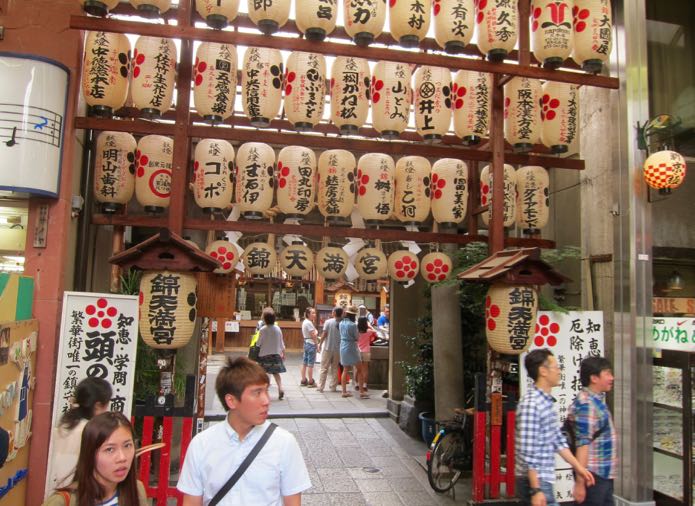
The Nishiki Market Food Tour is fun, interesting, and an excellent introduction to Kyoto culture.
The 30 Best Things To Do in Kyoto
1. Gion
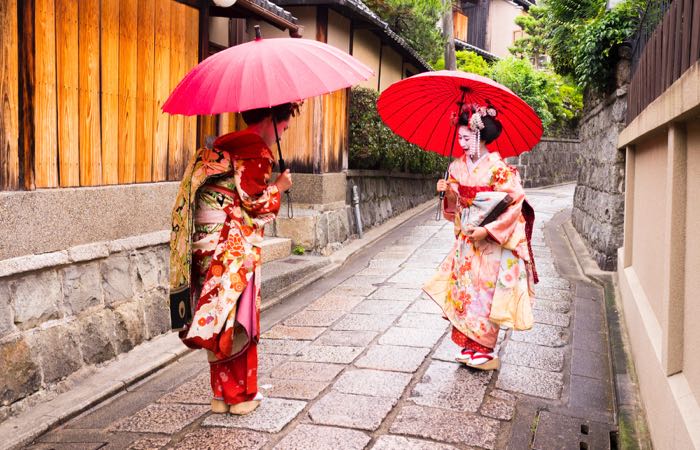
Of Kyoto’s five geisha districts, none is as famous as Gion. While geiko (as geisha are called in Kyoto) used to number in the hundreds, today only 250 or so remain, with fewer than 70 in Gion. One of the most popular things to do in Kyoto is to gather around Gion’s main street, Hanamikoji Dori, at dusk – in hopes of seeing a geiko or maiko (geisha apprentice) on her way to sing, dance, play the shamisen (three-stringed instrument) and perform other traditional arts at a Gion entertainment house. If you want to learn more about the life of a maiko in training, your best bet is to do the excellent Gion Evening Food Tour, which will lead you through Gion’s back streets as you learn how to spot a boarding house where maiko live and how to tell maiko and geisha apart. In Gion is also Gion Corner, providing a one-hour introduction to Japan’s ancient cultural arts with performances of flower arranging, the tea ceremony, music, dance and bunraku (Japanese puppetry).
• Nearest subway station: Shijo-Kawaramachi.
2. Chionin Temple
It’s not one of Kyoto’s most famous temples, but Chionin’s convenient location on the north edge of Maruyama Park and its remarkable Samnon main gate (one of Japan’s largest) make it a worthwhile quick stop for sightseers. On the other hand, for the millions of Japanese who follow the Jodo Shu (Pure Land Sect), this temple devoted to one of country’s most popular Buddhist sects is a magnet. Jodo Shu was founded by Honen (1133-1212), a monk who eschewed Buddhist practices of the time as being too aristocratic and too difficult for commoners to follow. Instead, he preached that anyone could attain enlightenment simply by chanting Namu Amida Butsu (“I entrust myself to Amida”) repeatedly and mindfully. If you have time, pay the small admission fee to stroll through Chionin’s two gardens, one dating from the early Edo Period and the other reconstructed in 1954 with a dry rock garden and a spring-fed pond. Its Mieido hall, home to a sacred image of Honen, however, is closed for renovation until 2019.
• Nearest subway station: Higashiyama.
• Nearest bus stop: Chionin Mae.
• Reviews
3. Eikando Temple
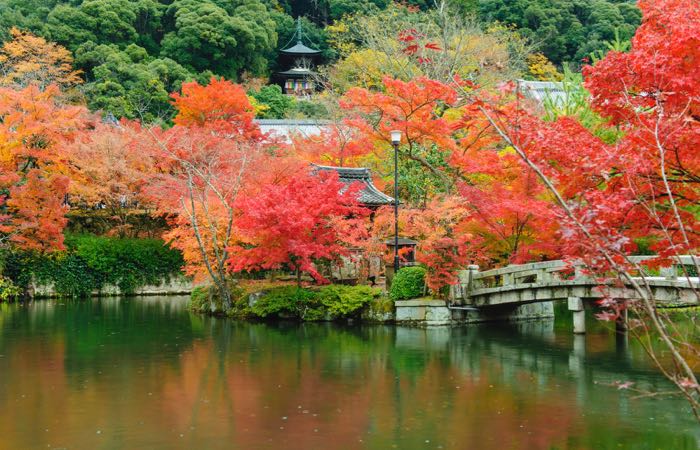
Formally called Zenrin-ji (“Temple in a Calm Grove”), this temple’s popular name honors head abbot Eikando (1033-1111), beloved among Japanese for his caring of the sick poor and planting plum trees to administer as medicine. The temple’s most famous attraction is the 12th-century statue of Mikaeri Amida, looking backward over his shoulder. According to popular lore, Eikando was circling a statue of Amida while reciting chants. Suddenly, he saw that Amida had stepped down from the altar, a sight so shocking that Eikando stopped in his tracks, whereupon the Amida glanced over his shoulder and remarked, “You are dawdling.” Other highlights include paintings drawn on fusuma (sliding doors), a hillside pagoda with views of Kyoto and a garden with a pond at its center. Autumn’s changing maple leaves and nighttime illuminations make this a busy place in November, but the rest of the year you might just have it to yourself.
• Nearest bus stops: Nanzen-ji Eikando-michi and Tenno-cho.
• Reviews
4. Kyoto Imperial Palace
This peaceful oasis in the middle of the city served as the imperial residence from 1331 until 1868, when the emperor was restored to power, upstart Tokyo was declared the new capital, and the imperial court left Kyoto. The grounds of the Kyoto Imperial Palace are open for self-guided tours along a specific route, which takes you past the main ceremonial hall, the emperor’s residence and other buildings, as well as the emperor’s private garden. Note that that what you see is not the original: like virtually all ancient structures in Japan, the imperial palace has been leveled by fire more than a dozen times, with present buildings dating from 1855. But also like most historic treasures, it has been rebuilt virtually exactly as it was, in this case a reproduction of palace architecture from Kyoto’s glorious Heian Period (749-1185). Although this palace doesn’t come close to the extravagance of Kyoto’s imperial villas like Katsura, it’s much easier to visit and more conveniently located (entrance is through the palace’s west Seishomon Gate).
• Nearest subway stop: Imadegawa.
• Nearest bus stop: Karasuma-Imadegawa.
• Reviews
5. Fushimi Inari-taisha Shrine
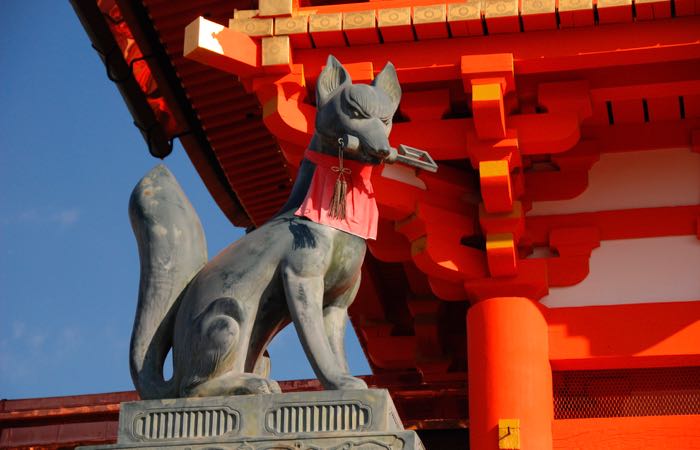
Fushimi Inari-taisha Shrine with its 5,000 orange-colored torii gates has been here for more than 1,300 years, but only recently has become a must-see destination for foreigners. It was founded in 711 when Inari, the god of rice and sake, was enshrined on nearby Mt. Inari. In the ensuing years, it became a popular destination for merchants praying for success, and has accrued thousands of vermillion-colored torii donated through the centuries by worshippers (and more recently by Japanese businesses). These form a neon-colored tunnel along sloping pathways, and make for one of the most photogenic shrines in Japan. On the hillside are also shops selling refreshments, many miniature shrines and monuments, and stone statues of foxes, said to be messengers of the gods and keepers of granaries because of the keys dangling from their mouths. Although you can come just for a quick photo op (it’s on the same train line between Kyoto and Nara), pathways leading through woods to the top of Mt. Inari also make for a good outing.
• Nearest train stations: Inari and Fushimiinari Station.
• Reviews
6. Kyoto International Manga Museum
The world’s largest manga museum is a must not only for fans of Japanese graphic novels but also for those wishing to understand why this popular genre has take the world by storm. Housed in a 19th century elementary school, it holds some 300,000 items in its collection, with the purpose not only to preserve manga both old and contemporary but also to facilitate research. Visits begin with the museum’s main exhibit, called “What is Manga,” which goes way beyond just an introduction: displays include historic cartoons from the late Edo Period, examples of the wide diversity of Japanese and international manga, explanations of how manga is created and mass produced, and related subjects like anime and cosplay. One of the museum’s most popular features is its “Wall of Manga,” with about 50,000 publications from the 1970s to the present lined up on bookshelves that anyone can select and read. Although there are examples of manga in English and other languages, most publications here are in Japanese, but that doesn’t make the illustrations any less fascinating. (There’s also a children’s library with manga and picture books geared toward them.) True fans won’t want to miss the museum shop for its manga, postcards, pastries, and original goods you can’t find anywhere else.
• Nearest subway station: Karasuma-Oike.
• Reviews
7. Ginkaku-ji
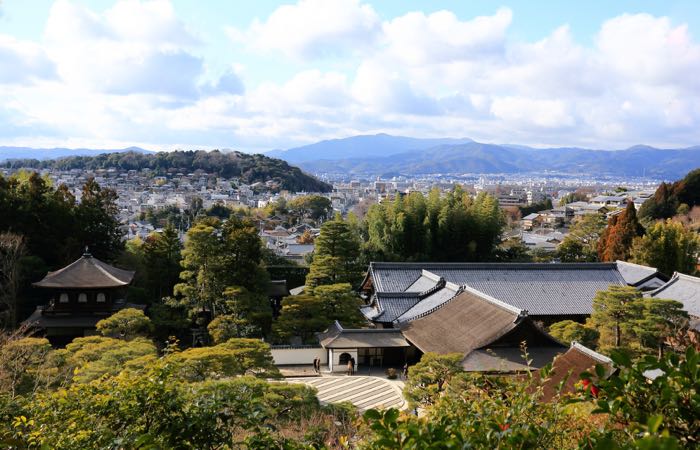
The Silver Pavilion isn’t silver at all, but it’s famous anyway for its architectural perfection, miniature Mt. Fuji and moss garden. It was built in 1482 as a retirement villa for shogun Ashikaga Yoshimasa and became a temple after his death in 1490. Although Yoshimasa’s dream to cover the pavilion in silver foil in imitation of his grandfather’s Kinkakuji (Golden Pavilion) never came to fruition, Ginkakuji’s simple wooden structure is arguably more aesthetically pleasing just as it is. In addition to the pond with the pavilion rising from its shore, there’s a sand garden with a huge cone-shaped sand replica of Mt. Fuji, said to look especially magical under a full moon. There are streams where Yoshimasa drew pure water for his tea ceremonies, as well as a moss garden that would set any poet’s heart swooning.
• Nearest bus stop: Ginkakuji-mae.
• Reviews
8. Byodoin Temple
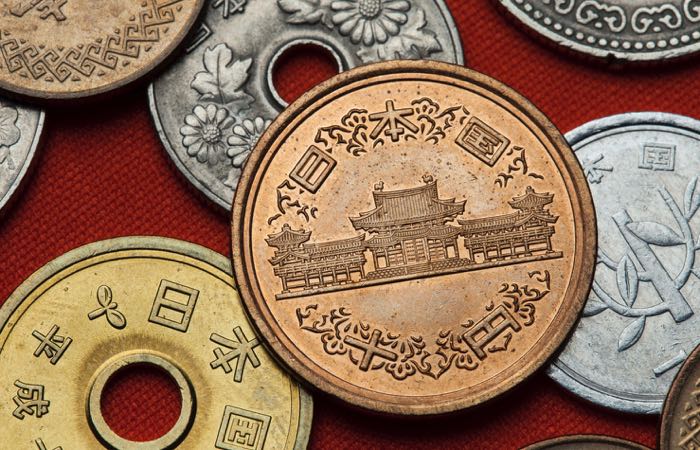
Byodoin Temple, 18 miles southeast of Kyoto, is so famous that it’s on the ¥10 coin. It was converted from a former villa in 1053, and though only its main Phoenix Hall (Hoo-do) remains (and is one of the few to have survived the fires and wars of the past 1,000-some years), it’s considered one of the finest examples of temple architecture from the Heian Period (794-1192). Said to resemble a phoenix with its two side wings and back corridor extending like a tail, it contains the Amida Nyorai seated Buddha, carved by the most famous sculptor of the Heian Period. Both Phoenix Hall and its Buddha are National Treasures, as are its massive temple bell and its 52 carvings of bodhisattvas flying through the clouds. To protect its priceless treasures, entrance to Phoenix Hall is restricted to 50 visitors at a time, on a guided tour conducted in Japanese (but with an English handout). If the wait is too long (up to two hours in peak season), you can still enjoy yourself viewing Byodoin from across a small lake and visiting the Treasure Museum, which does an excellent job portraying Phoenix Hall’s interior with virtual-reality exhibitions, computer graphics and murals.
• Nearest station: Uji (then a 10-minute walk).
• Reviews
9. Heian Shrine
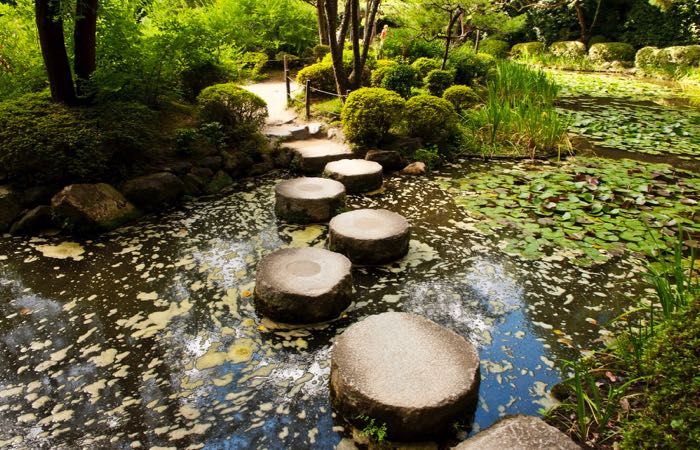
This 1895 replica of Kyoto’s first imperial palace might be Kyoto’s most well-known shrine, but its Shin’en Garden is what steals the show. Considered a fine example of a strolling garden typical of the Meiji Period (1868-1912) and featured in the movie Lost in Translation, it encircles a central pond and is famous for its weeping cherry trees in spring, its irises and water lilies that bloom in summer and its fiery-red maple leaves in the fall. Note, however, that those seasons also bring the crowds, so consider yourself just as lucky if you visit in the more tranquil off season. The shrine itself is a riot of orange, green and white, representative of Heian-era architecture, and was constructed to commemorate the 1,100th anniversary of Kyoto’s founding in 794. Heian Shrine hosts one of Japan’s most famous festivals, the Jidai Matsuri (Festival of the Ages), held on October 22 to commemorate Kyoto’s founding, and featuring a parade of 2,000 people dressed in period costumes.
• Nearest bus stop: Kaikan Bijutsukan-mae.
• Reviews
10. Kyoto Museum of Traditional Crafts
This free museum introduces Kyoto’s long history of traditional crafts, many developed by artisans to serve the imperial court during the 1,100 years the city served as the nation’s capital. More than 75 types of handicrafts are on display, including elaborate kimono textiles, lacquerware, Buddhist altars, pottery, folding fans, stone lanterns, noh masks, Japanese dolls, and even fishing rods and boxwood combs. Informative descriptions and videos describe the step-by-step process required to produce Kyoto’s crafts, along with artisans demonstrating their skills most days of the week. Maiko (geisha apprentices) perform a short dance every third Sunday of the month, and if you want, you can participate in a workshop on stencil-dyeing for a small fee (check the website for an update on activities). It’s worth perusing the many fine goods in the museum’s gift shop.
• Nearest subway station: Higashiyama.
• Nearest bus stops: Higashi-Nijo or Kyoto Kaikan Bijutsukan-mae.
• Reviews
11. Katsura Imperial Villa
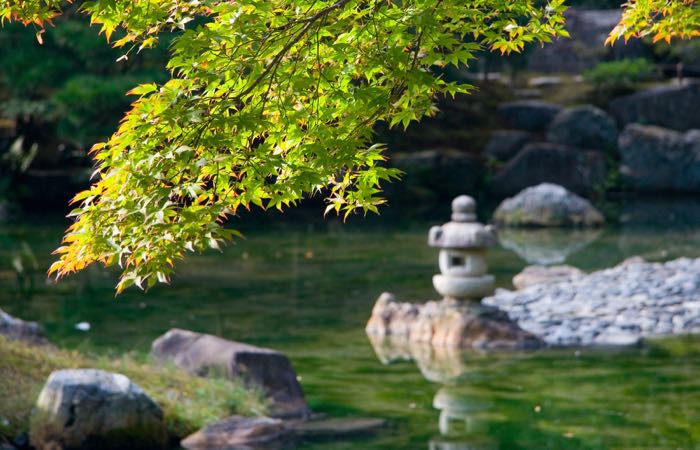
Katsura is considered the finest example of traditional architecture and gardening in Japan. Built in the 1620s as the private estate for members of the imperial family, it features a strolling garden around a pond and is as perfect as they come, with each bend in the pathway and every islet, tree, bush, stone lantern, and bridge carefully placed to afford a graceful and harmonious view. There’s a moon-viewing pavilion, teahouse and other simple yet elegant structures, made with natural materials that blend seamlessly with their surroundings. Katsura can be visited only on one-hour guided tours conducted in Japanese (free audio guides in English are provided) – make reservations online in advance, or chance it: 20 slots are available at the villa on a first-come first-served basis, but you should arrive well ahead of the scheduled tour if you want to snag a spot. Check the website for more information. While a visit here is rewardingly memorable, seeing Katsura takes time and effort, so make sure you’ve seen the ancient city’s other must-see stops before coming here.
• Nearest station: Katsura, followed by a 20-minute walk.
• Nearest bus stop: Katsura Rikyu-mae stop, followed by an 8-minute walk.
• Reviews
12. Kawai Kanjiro Memorial House
This 1930s home and studio of one of Japan’s most famous 20th-century potters provides insight to his creative talents and free-thinking life’s philosophy. Famous for creating his own natural glazes and co-founding the Japanese folk-art movement, he nevertheless refused the honor of being designated a Living National Treasure and never signed his pieces. A writer, architect and sculptor as well as a potter, Kawai designed the home himself and handcrafted much of its furnishings, from its wooden stools to its cabinets. It’s a traditional Japanese home, with an open-pit fireplace in the main living area, tatami rooms and a garden, and it’s filled with practical yet beautiful items. His “climbing kiln” out back is just as he left it, built along a slope in the traditional Japanese method. Although located within walking distance of Sanjusangendo and Kiyomizu temples, this worthwhile destination is off the beaten track and is highly recommended if you haven’t seen many Japanese homes or simply have an appreciation for beautiful things.
• Nearest bus stop: Umamachi.
• Reviews
13. Kinkakuji
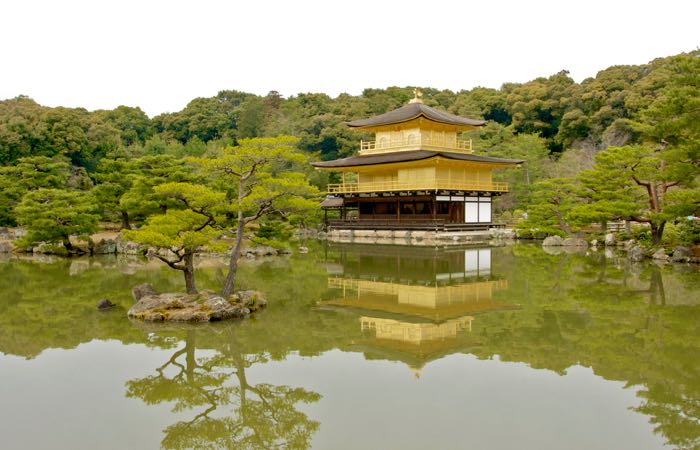
The Golden Pavilion, as it’s known in English, is one of Kyoto’s most photographed temples. It dates from the 1390s, when it was constructed as a luxurious retirement villa for a shogun. After his death, the gold-leafed pavilion became a famous Zen temple, gaining even more fame in 1950 when a novice monk burned it to the ground, a story fictionalized in Yukio Mishima’s book, The Temple of the Golden Pavilion. Rebuilt soon thereafter, the phoenix-topped three-story pavilion draws huge crowds today, its stunning gold color even more striking when contrasted by a deep blue sky and reflected in an islet-studded pond. The shrine’s temple contains relics relating to the Buddha, but it is not open to the public – visits here are restricted to viewing the Golden Pavilion and its reflection in the water on a walk around the pond, or strolling through the beautiful moss-covered Japanese garden, considered an excellent example of gardens completed during the Muromachi Period (1336-1573). Late afternoon is often the optimal time for photographs, but because crowds can be overwhelming, you might consider visiting first thing in the morning.
• Nearest bus stops: Kinkakuji-mae or Kinkakuji-michi.
• Reviews
14. Kiyomizu-dera Temple
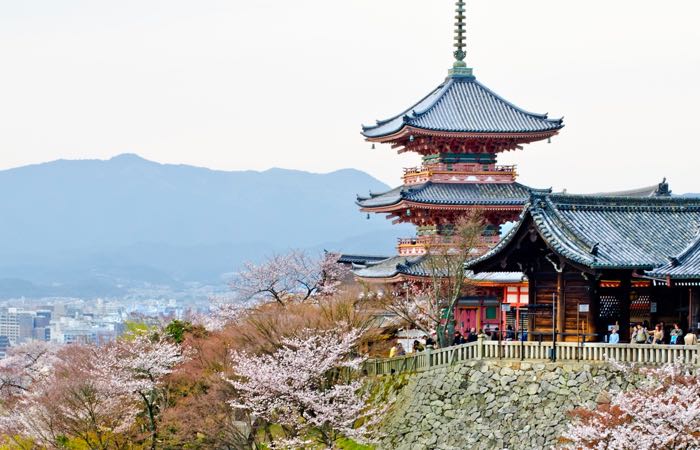
Kyoto’s most famous temple is a cliff-hanging architectural masterpiece. Located on the slopes of Mt. Otowa on the eastern edge of the city, it’s one of the city’s oldest temples, founded in 798 and rebuilt as it largely stands now in 1633 under orders of the third Tokugawa shogun. The temple’s main hall is constructed over a cliff, supported by 18 gigantic pillars up to 6 feet in circumference and 39 feet high – all built without the use of nails and so well designed that they’ve withstood earthquakes for almost 400 years. Most visitors spend a few hours here, first browsing the many souvenir shops that line the slopes leading to Kiyomizu and then enjoying the views of a distant modern Kyoto from the main hall’s verandah. They then stroll to the three-story pagoda and join the queue to drink the pure water of Otowa Falls, said to bring good health and to grant wishes (Kiyomizu translates as “pure water”). There are several kiosks with open-air seating offering simple snacks, good for people-watching and enjoying cherry blossoms or changing maple leaves in season. Don’t miss Jishu Shrine behind the main hall, a vermillion-colored shrine dedicated to the god of love and matchmaking.
• Nearest bus stop: Gojozaka.
• Reviews
15. Kodaiji Temple
This diminutive temple may not be on the radar of international visitors with only a few days to spare, but it’s famous among Japanese. That’s because it’s dedicated to historic hero Toyotomi Hideyoshi, a samurai, feudal lord, general, and politician, who succeeded in ending two centuries of bloody civil wars and unifying Japan. A mausoleum containing wooden statues of Toyotomi and his wife, Nene, is famous for its lacquered surfaces sprinkled with gold and silver, but it’s the garden that receives accolades, designed by famous landscape architect Kobori Enshu and containing a strolling pond garden and a rock garden. There are also two teahouses (Toyotomi was a disciple of the tea ceremony) and a bamboo grove up the hill. During specific weeks in spring, summer and autumn, Kodaiji mounts an imaginative and magical lighting display you won’t want to miss if you’re in town.
• Nearest bus stop: Higashiuyama Yasui.
• Reviews
16. Kyoto National Museum
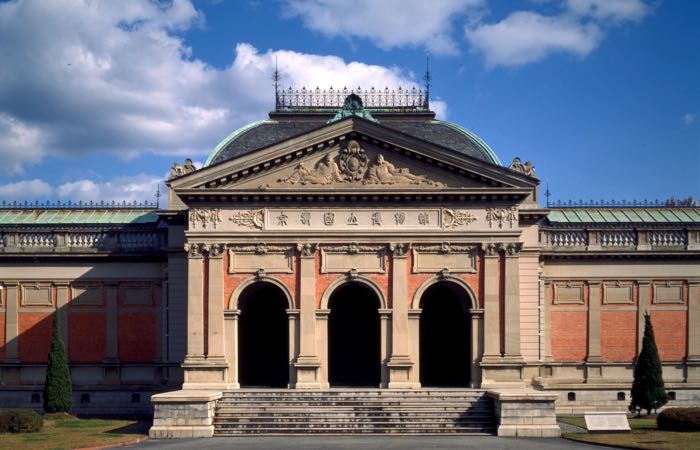
Many treasures that once filled Kyoto’s countless temples, shrines, imperial palaces and estates are preserved in this 1897 French baroque-style building built just for the collection. Considered one of Japan’s most distinguished museums, it’s the best place to see the superb craftsmanship for which Kyoto is famous, including paintings, statues, textiles, lacquerware, and more. While it’s especially known for its collection of objects from the Heian Period (794-1192), a time when the arts flourished, it also displays artifacts from other ages and places, such as 6th-century Haniwa burial figurines, Japanese sutras, ceramics from the Nara through Edo Periods, and Chinese paintings. The museum’s holdings are so vast, the permanent exhibit can only show them on a rotating basis, along with special exhibitions.
• Nearest bus stop: Hakubutsukan Sanjusangendo-mae.
• Reviews
17. Maruyama Park
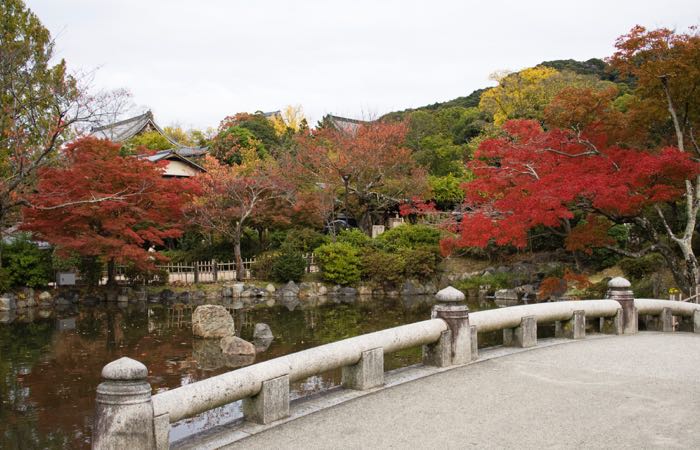
Kyoto’s most famous viewing spot during the cherry blossom season serves as a peaceful urban oasis during the rest of the year. If you’re with kids, it’s a convenient place to unwind, get some ice cream from one of the park’s kiosks and watch the fish and birds along the shores of the central pond. There are plenty of benches on which to relax, along with paths that wind through orchards and gardens. During the cherry blossom season, however, usually in late March or early April, the park becomes one of Kyoto’s star attractions, filled with people who spread tarps under the trees and vendors selling snacks and beer. The park’s most famous tree is a weeping cherry, which is lit at night and attracts more visitors than you’d ever think possible.
• Nearest bus stop: Gion.
• Reviews
18. Nanzen-ji Temple
This Zen temple, established in 1291 on the grounds of Emperor Kameyama’s retirement villa, boasts one of Kyoto’s most imposing temple gates at its entrance, constructed in 1628 to honor those who died in the fierce battle at Osaka Castle between imperial troops and samurai warriors. The Hojo main hall, once part of the Kyoto Imperial Palace (reconstructed here in 1611), has an attached rock garden designed by famous landscape artist Kobori Enshu. While the garden’s rocks are said to resemble tigers, more easily identifiable images can be found on painted sliding doors in the building behind the Hojo, which show tigers drinking amidst a bamboo grove. Emperor Kameyama’s influence is evident in another temple here, Nanzen-in, where you’ll find his mausoleum and a garden said to have been created by the emperor himself.
• Nearest subway station: Keage.
• Nearest bus stop: Nanzenji Eikando-michi.
• Reviews
19. Nara Park
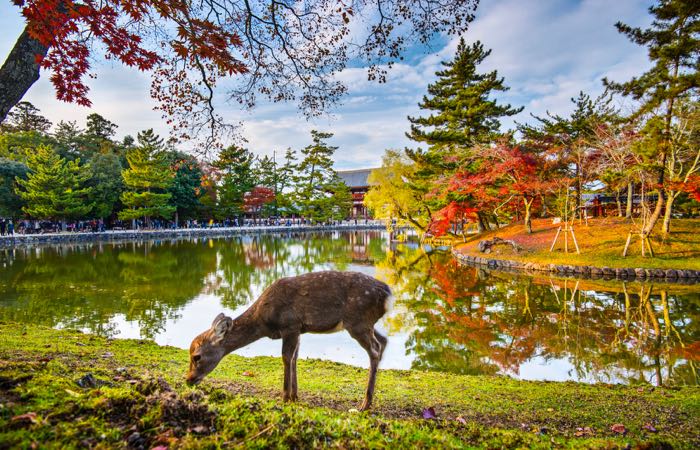
A side trip from Kyoto, 1,300-acre Nara Park is one of the top destinations in Japan. It served as the nation’s capital in the 8th century, at a time when Buddhism and Japanese arts, architecture, and literature flourished. Remarkably, some of that ancient capital survives, and you’ll find temples, treasure houses, and more than 1,000 free-roaming deer. (They might even bow as they come for a handout of deer cookies sold in the park – understandably, children love this.) Don’t miss Kofukuji Temple with Japan’s second-tallest pagoda, priceless statues in its Eastern Golden Hall, and the Treasure House full of works originally contained in the temple’s 170-some buildings, many of them National Treasures. Other sites here include Nara National Museum, containing Buddhist art and other gems, and Kasuga Shrine with its 3,000 stone and bronze statues. But the main star of Nara Park is Todaiji Temple, where you’ll find Japan’s largest wooden structure and Japan’s second-largest bronze Buddha.
• Nearest train stations: JR Nara and Kintetsu Nara stations, from which it’s a 5- to 10-minute walk to the park.
• Reviews
20. Nijo Castle
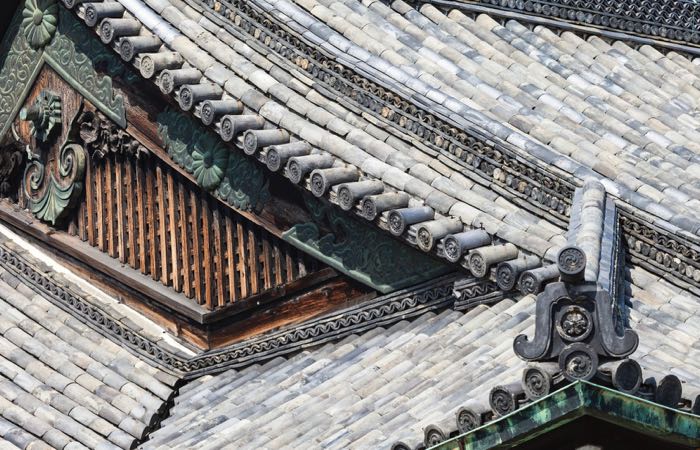
This outstanding example of 17th-century Momoyama-era architecture was the residence of the shogun during his visits to the Imperial Court in Kyoto. Unlike most castles from the era, which were built mostly for defense, Nijo Castle was constructed to display the shogun’s power and wealth. The primary structure, Ninomaru Palace, boasts 33 rooms, exquisite transom woodcarvings and vibrantly painted sliding doors, though compared to the ornately decorated European castles of the time, the shogun’s quarters seem austerely sparse. Some of Nijo Castle’s most interesting features are its defenses, including a moat, “nightingale” floors that creaked like songbirds when trod upon, and secret alcoves for bodyguards ready to protect their lord. Unfortunately, like most historic buildings in Japan, photographs inside the castle are not allowed. Save those for the extensive garden, designed by famous gardener Kobori Enshu. With its ponds studded with islets of stone and pine trees, it’s especially beautiful when the many cherry and plum trees are in bloom.
• Nearest subway station or bus stop: Nijojo-mae.
• Reviews
21. Nishijin Textile Center

Part shop, workshop, and museum, the Nishijin Textile Center is located in what was once a neighborhood of weavers, with as many as 7,000 looms at work during the Edo Period (1603-1867). As Japan’s capital for more than 1,000 years, Kyoto needed an army of artisans to create the elaborate clothing worn by the imperial family, Buddhist monks and Shinto priests. Exhibits demonstrate a textile’s transformation from ugly silkworm to beautiful fabric, with many elaborate handlooms on display. Highlights are the seven free kimono fashion shows each day, which change seasonally. With reservations and by paying an extra fee, visitors can try their own hand at weaving a tablemat or scarf, don a yukata for a stroll on Kyoto’s streets, or try on an elaborate 12-layer kimono typically worn by a maiko (geisha apprentice) or geiko (professional entertainer). Of course, there’s also the ubiquitous museum shop filled with silk kimono, purses, ties and other goods.
• Nearest subway stop: Imadegawa.
• Nearest bus stop: Horikawa Imadegawa.
• Reviews
22. Nishiki Food Market
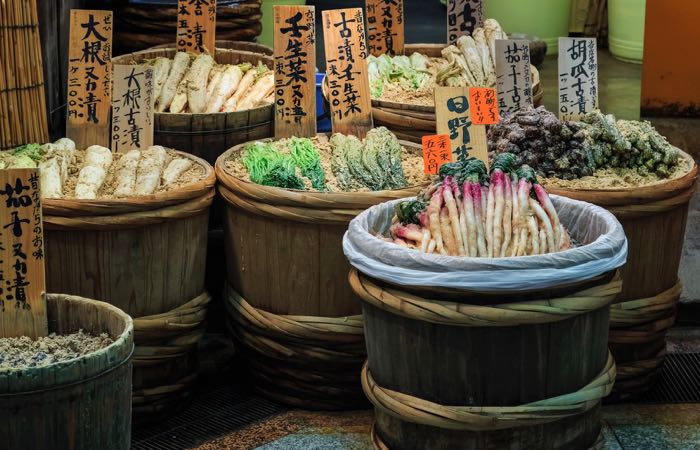
This outdoor food market, sometimes referred to as “Kyoto’s Kitchen,” sells and showcases the city’s many culinary treasures. Its history stretches back some 400 years – some of the 130-some stalls and stores have been selling their specialties for centuries. Located right downtown on Nishiki-koji Dori, the five-block covered shopping arcade is lined with vendors offering fresh seafood and produce (most of it local and seasonal), and other regional specialties like sweets, pickled vegetables, dried seafood, and yuba (tofu skin). Everyone from housewives to the city’s top chefs shop here. There are also vendors selling cooked foods for snacks or takeout, as well as shops that sell crafts, souvenirs, teas, and kitchenware. It’s an interesting street to explore, even if you aren’t in the market to buy anything.
• Nearest subway station: Shijo.
• Reviews
23. Philosopher’s Path
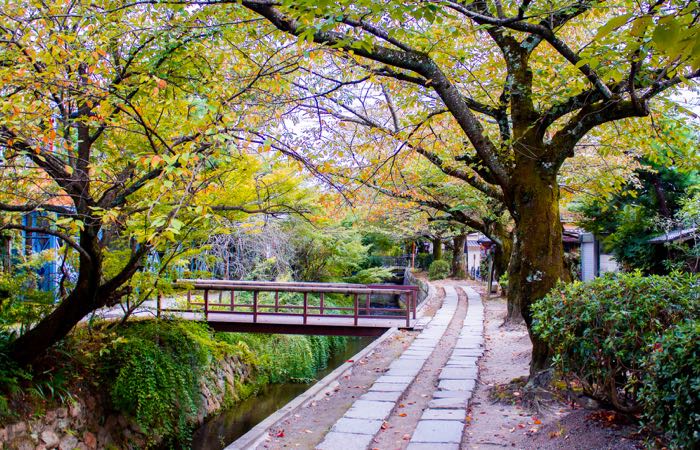
A great urban getaway, Kyoto’s Philosopher’s Path is a pedestrian lane that follows a narrow canal lined with cherry trees. It’s said to get its name from a philosopher who strolled its path on his way to Kyoto University, but it’s easy to imagine this scenic route inspiring grand thoughts in anyone who’s lucky enough to walk its approximate one-mile length. Located on the outskirts of a quiet residential neighborhood, the path passes several former homes that have been converted into low-key cafes and shops, but there are sightseeing opportunities as well: the walk can be easily combined with visits to Ginkakuji at its northern end and to Eikando and Nanzen-ji on the tail of its southern end. Although the pathway is tranquil most of the year, the cherry-blossom season brings crowds of admirers.
• Nearest bus stops: Ginkakuji-mae, Ginkakuji-michi or Nanzenji Eikando-michi.
• Reviews
24. Pontocho

This tiny, cobblestone alleyway used to be the domain of exclusive restaurants, hostess bars and geisha entertainment houses, with access granted only to those with connections and lots of money. In the past few decades, however, Pontocho has become more egalitarian, with bars and restaurants in a range of price categories catering to people of all ages and nationalities. Located just west of the Kamo River and stretching from Sanjo to Shijo Dori streets, Pontocho is very atmospheric, with many establishments opening onto verandahs built on stilts over the river for al-fresco dining in summer. Paralleling Pontocho to the west is another nightlife mecca called Kiyamachi, which runs alongside the Kiyamachi canal – its bars, cheap eateries and live music venues serve mostly a younger crowd. No one should miss a stroll along the banks of the Kamo River itself, where young people gather and couples meet for dates, and where the lit backsides of restaurants and the open-air verandahs provide a timeless vision of one of the world’s greatest cities.
• Nearest subway station: Kawaramachi.
• Reviews
25. Toei Kyoto Studio Park
A few hours at this working movie studio/theme park based on feudal Japan makes a fun alternative to visiting yet another temple – particularly for families. Indoor and outdoor movie sets re-create a picturesque Japanese village during the days of the shogun and the late 1800s. You might even catch a work in progress: over 200 movies a year are filmed here by this major Japanese film company. If you wish, stop by the costume rental shop to dress as a samurai, ninja or geisha, have your picture taken, and then spend the rest of your time touring the park in costume. Admission to the park includes a 20-minute ninja show, an animation museum with objects used in Toei’s films, an indoor playground, street performances and more. Many of the park’s coolest attractions cost extra, however; like a maze-like ninja escape house with trap and revolving doors. Note that the Toei Kyoto Studio Park is low key and modest compared to Hollywood theme parks, but it’s a fun way to pass a morning or afternoon; some kids might even rate it one of their best experiences in Kyoto.
• Nearest station: Uzumasa.
• Reviews
26. Ryoanji
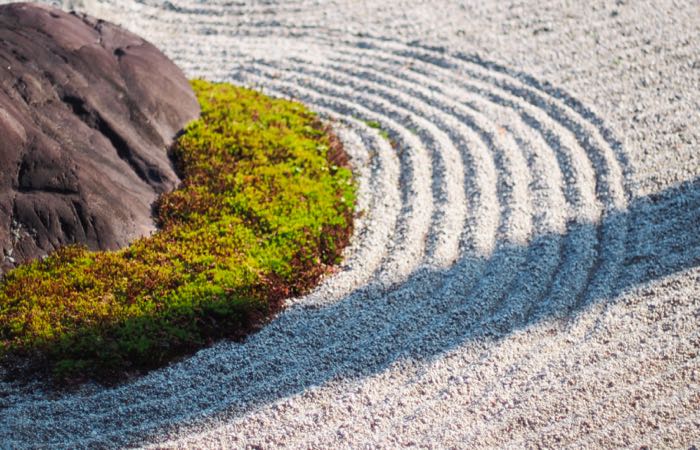
Ryoanji has the fortune – or perhaps misfortune – of being the most famous rock garden in Japan. Because of the number of tourists who come here, it’s hard to sit meditatively and simply take in the view, unless you’re lucky to miss one of the many tour groups. In addition, some visitors, expecting something grand, may be disappointed in the rock garden’s diminutive size, measuring just 80 feet long and 30 feet wide. Laid out in the Muromachi Period (1336-1573) and part of the Historic Monuments of Ancient Kyoto World Heritage Site, the garden is enclosed by a beautiful earthen wall on three sides and by a verandah on the other, from which you can sit and ponder the mystery of who built it and why. Its design is very simple—just 15 rocks of various sizes placed in beds of moss surrounded by raked, white gravel. Interpretation is left to the beholder: does the scene resemble mountains rising from the mist, islands surrounded by the sea, or something entirely different? In addition to the rock garden, there’s a large pond and a restaurant serving one of Kyoto’s specialties, yudofu (tofu simmered with vegetables).
• Nearest bus stop: Ryoanji-mae or Ritsumeikan Daigaku-mae.
• Reviews
27. Saihoji Moss Garden
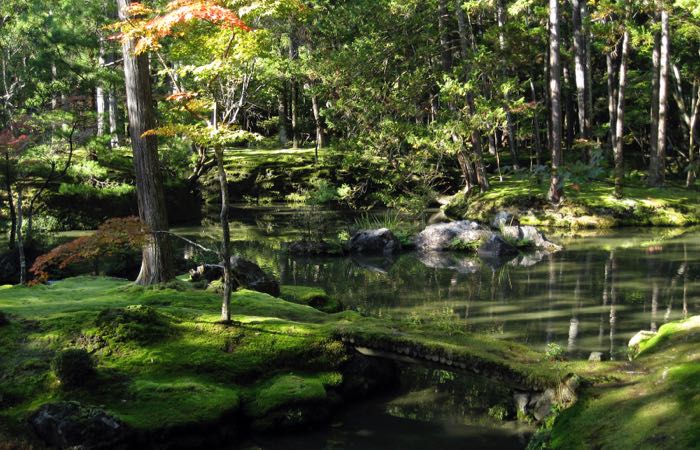
It’s not an easy procedure to visit Kyoto’s Saihoji Moss Garden (popularly called Kokedera: Moss Temple), but the hassle is well worth it – its lush and peaceful grove filled with over 120 moss varieties is one of Kyoto’s most mystical sights. Reservations must be made 7 days to 2 months in advance by mailing your name, address, age, number of people in your group and three dates you’d be able to visit. For the return of a postcard confirming your visit, you also need to include a self-addressed envelope either to your hotel in Japan or, along with International Reply Coupons, to your home address. Alternatively, for an extra fee, there’s a Japanese webservice that will do the work for you. Regardless, you’ll be told when to arrive (be sure to have that postcard confirmation with you), whereupon you and the other tour participants will be led to a room for chanting and writing sutras. After this initial ceremony, you’ll be allowed to visit the moss garden at your leisure. Be sure to take your time, taking in the views around the pond (shaped in the kanji character for “heart”) and enjoying the fairy-tale-like atmosphere around you.
• Nearest station: Kami-Katsura Station, followed by a 15-minute walk.
• Reviews
28. Sanjusangendo Hall
At some 400 feet long, Sanjusangendo Hall Temple is the world’s longest wooden building, but even more incredible are the statues it contains. The largest is a seated Kannon, carved in 1254 by Tankei, one of Japan’s most famous sculptors from the Kamakura Period – but it’s the sheer number of Kannon statues that make this one of Japan’s most impressive sights: a thousand life-size statues, standing 10 deep in 50 columns. Carved out of cypress in the 12th and 13th centuries, each statue has 40 arms, and hands capable of saving 25 worlds. And as if that weren’t enough, there are also 28 statues of guardian deities, an intact collection so rare they are National Treasures. The building’s incredible length provides another purpose: for centuries, archery competitions have been held in the back corridor. Like most historic buildings in Japan, no photographs are allowed, so your memories will serve as momentos of the most remarkable collection of Japanese Buddhist statues you’re ever likely to see.
• Nearest bus stop: Hakubutsukan Sanjusangendo-mae.
• Reviews
29. Shugakuin Imperial Villa
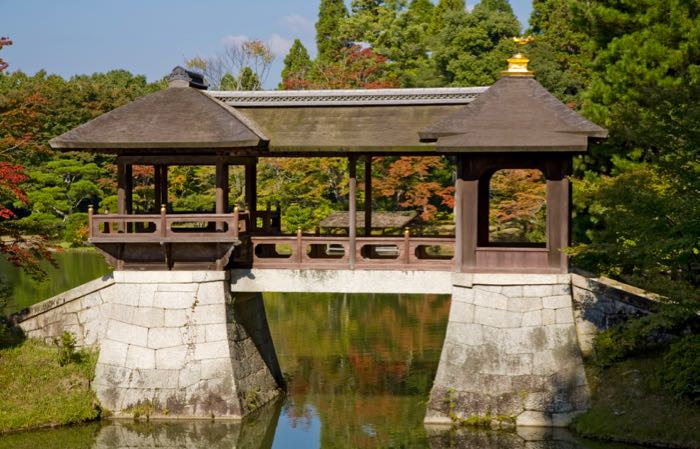
Shugakuin is more spacious and boasts more natural looking grounds than Kyoto’s other imperial villas that are open to the public. It was built in the mid-1600s for Emperor Gomizunoo, who ascended to the throne when he was only 15 and renounced it 18 years later. Located on the slope of Mt. Hiei, its 133 acres ascend the hillside in three level areas, each with its own garden and villa. The upper garden, with its lake and waterfall, is considered the most grand, while the middle garden is known for its beautiful “Shelves of Mist,” made of zelkova wood. Shugakuin is especially known for incorporating a technique known as “borrowed landscaping”: drawing upon the surrounding countryside to enhance and add to garden design. Views from Shugakuin are grand, especially from the upper garden. Shugakuin can be visited only on a guided tour, which last about 1 hour and 15 minutes. You’re best off applying online far in advance, though 35 spaces are allotted for afternoon tours on a first-come, first-serve basis: arrive early if you’re willing to take a chance.
• Nearest station: Shugakuin, then a 20-minute walk.
• Nearest bus stop: Shugakuin-rikyu-michi, then a 15-minute walk.
• Reviews
30. Toji Temple
Toji temple boasts Japan’s tallest pagoda and a monthly flea market that’s the largest and oldest in Japan. Now part of the Kyoto World Heritage Site, the temple was founded as one of two temples guarding the city’s southern edge, shortly after Kyoto became the nation’s capital in 794. It achieved notoriety, however, when the emperor presented the temple to the monk Kukai (posthumously known as Kobo Daishi), who made it the headquarters of the Shingon sect of Buddhism. Although Toji’s various buildings, religious treasures, garden, and pagoda are worth a visit, it’s the temple’s flea market (held the 21st of every month) that attracts the crowds: Spread throughout the temple’s expansive grounds, it’s packed with vendors selling antiques, second-hand kimono, pottery, bonsai, vegetables, crafts and much more. A smaller market, devoted just to antiques, is held on the first Sunday of every month.
• Nearest stations: Kyoto and Toji.
• Reviews
About Santorini Dave